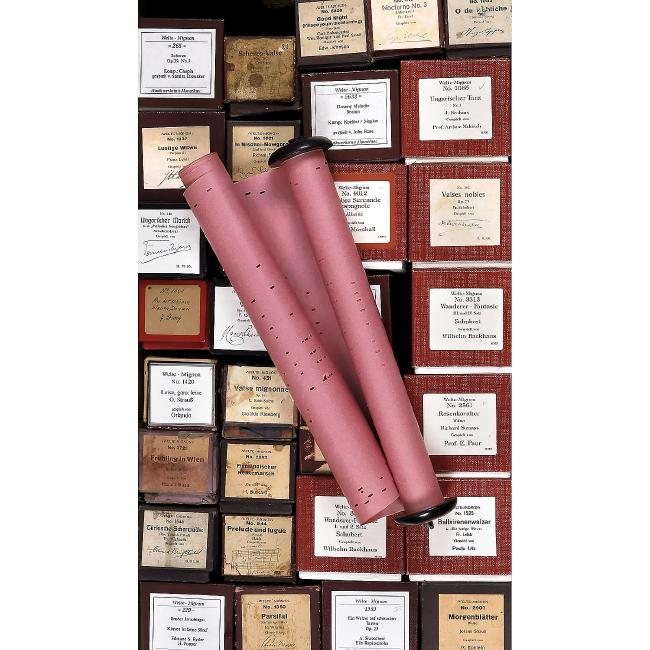Exceptional 18-Carat Curved Musical Gold Snuffbox, c. 1812 No. 203, with five-pillared barillet movement playing a single air, pinned spring-barrel inscribed "96", spring signed and dated "Carrisot 9/12", two stacks of nine and ten double 'grasshopper' teeth, curved gold case with engine-turned panels, chased and engraved borders, two compartments (one for the mechanism, the other for snuff or the key) with flaps and polished interior stamped "DG" in a diamond, "18K" and two clover symbols, 3 3/8 x 2 1/8 in. (8,5 x 5,4 cm), fine restored playing condition. With key. - Literature: For Niko Wiegman's detailed photographs of the movement during restoration, see Luuk Goldhoorn, "A Musical Snuff Box of Exceptional Form" in: "Mechanical Music" (MBSI), vol. 58, no. 5, September/October 2012, pp. 19-22. - Describing the unusual case design, Goldhoorn notes, "the slight curve … was specifically made to rest in a pocket, to fit snugly against the curvature of the body". Carrisot was a maker of springs active during the late 18th and early 19th century, dating the example offered here, Goldhoorn argues, to a period ten years after the first musical ring by Piguet et Capt came onto the market. - An exhibition piece and objet de vertu from the earliest days of the musical box. Außergewöhnliche Gold-Tabakdose (18 Karat) mit Musikautomat, um 1812 Nr. 203, 1 Melodie, von 5 Säulen getragenes Barillet-Musikwerk, Stifte auf dem Federgehäuse, handgraviert mit "96", Feder signiert und datiert "Carrisot 9/12" (September 1812), 2 Stapel von 9 und 10 Tönen in "Grashüpfer"-Form, gebogenes Goldgehäuse, guillochierte Paneele, ziselierte und gravierte Kanten, 2 Fächer (für das Musikwerk und für den Schnupftabak oder den Schlüssel), innen poliert, mit Punzen "DG" in Raute, "18K" und zwei Klee-Symbolen, Maße 8,5 x 5,4 x 1,5 cm, fein restaurierter und spielender Zustand. Mit Schlüssel. - Literatur: Niko Wiegmans detaillierte Photos während der Restaurierung dieses Musikwerks siehe: Luuk Goldhoorn, "A Musical Snuff Box of Exceptional Form" in: "Mechanical Music" (MBSI), Band 58, Nr. 5, September/Oktober 2012, S. 19-22. - Goldhoorn merkte an, daß die gebogene Form des Gehäuses ideal ist, um die Dose in einer Tasche am Körper zu tragen. - Carrisot war ein Hersteller von Federn im späten 18. und frühen 19. Jahrhundert, was dabei hilft, dieses Werk zu datieren: zehn Jahre nach den ersten Fingerringen mit Musikwerken von Piguet et Capt. - Ein Ausstellungs- und Kunstobjekt aus den frühesten Tagen der Musikdosen.
Exceptional 18-Carat Curved Musical Gold Snuffbox, c. 1812 No. 203, with five-pillared barillet movement playing a single air, pinned spring-barrel inscribed "96", spring signed and dated "Carrisot 9/12", two stacks of nine and ten double 'grasshopper' teeth, curved gold case with engine-turned panels, chased and engraved borders, two compartments (one for the mechanism, the other for snuff or the key) with flaps and polished interior stamped "DG" in a diamond, "18K" and two clover symbols, 3 3/8 x 2 1/8 in. (8,5 x 5,4 cm), fine restored playing condition. With key. - Literature: For Niko Wiegman's detailed photographs of the movement during restoration, see Luuk Goldhoorn, "A Musical Snuff Box of Exceptional Form" in: "Mechanical Music" (MBSI), vol. 58, no. 5, September/October 2012, pp. 19-22. - Describing the unusual case design, Goldhoorn notes, "the slight curve … was specifically made to rest in a pocket, to fit snugly against the curvature of the body". Carrisot was a maker of springs active during the late 18th and early 19th century, dating the example offered here, Goldhoorn argues, to a period ten years after the first musical ring by Piguet et Capt came onto the market. - An exhibition piece and objet de vertu from the earliest days of the musical box. Außergewöhnliche Gold-Tabakdose (18 Karat) mit Musikautomat, um 1812 Nr. 203, 1 Melodie, von 5 Säulen getragenes Barillet-Musikwerk, Stifte auf dem Federgehäuse, handgraviert mit "96", Feder signiert und datiert "Carrisot 9/12" (September 1812), 2 Stapel von 9 und 10 Tönen in "Grashüpfer"-Form, gebogenes Goldgehäuse, guillochierte Paneele, ziselierte und gravierte Kanten, 2 Fächer (für das Musikwerk und für den Schnupftabak oder den Schlüssel), innen poliert, mit Punzen "DG" in Raute, "18K" und zwei Klee-Symbolen, Maße 8,5 x 5,4 x 1,5 cm, fein restaurierter und spielender Zustand. Mit Schlüssel. - Literatur: Niko Wiegmans detaillierte Photos während der Restaurierung dieses Musikwerks siehe: Luuk Goldhoorn, "A Musical Snuff Box of Exceptional Form" in: "Mechanical Music" (MBSI), Band 58, Nr. 5, September/Oktober 2012, S. 19-22. - Goldhoorn merkte an, daß die gebogene Form des Gehäuses ideal ist, um die Dose in einer Tasche am Körper zu tragen. - Carrisot war ein Hersteller von Federn im späten 18. und frühen 19. Jahrhundert, was dabei hilft, dieses Werk zu datieren: zehn Jahre nach den ersten Fingerringen mit Musikwerken von Piguet et Capt. - Ein Ausstellungs- und Kunstobjekt aus den frühesten Tagen der Musikdosen.















Try LotSearch and its premium features for 7 days - without any costs!
Be notified automatically about new items in upcoming auctions.
Create an alert